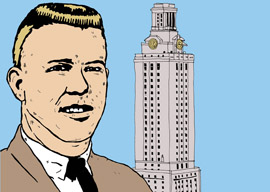
December 19, 2012

Charles Whitman
Not all mass shootings are equally exploitable by the media, however. Remember the middle-aged Korean male nursing student with the seemingly memorable name One Goh who murdered seven people last April?
Me, neither.
Sometimes the press jumps out ahead of the facts. For example, after the GOP retook the House in 2010, many instantly assumed that the Tucson shooter was a Sarah Palin or Glenn Beck fan. It turned out that was wholly wishful thinking. But then, you haven”t heard much from Sarah Palin or Glenn Beck lately, have you? (Holding the megaphone means never having to say you are sorry.)
Other slaughters raise tricky issues. For example, the shooting at the first night of the last Batman movie had potential, what with suspicions that director Christopher Nolan is some kind of conservative. But he’s been prudent in his statements over the years, and it would have been much too hard to explain.
A couple of years ago, some reporters tried to jump on the story of the former Connecticut mass-murder record-holder Omar Thornton, a black thief who murdered eight white men in 2010 for being “racist.” More than a few newshounds assumed it was their duty to document just how badly the victims had it coming.
But within a week, wiser heads in the press prevailed: This is not the story of racial hate and mass murder you”re looking for. It’s supposed to be the white guy killing eight blacks, not vice-versa. Even though Thornton used the magic R-word, he was, when you stop and think about it, a mass murderer. We don”t want anybody to hear about this shooting and start thinking it’s maybe time for a national conversation on whether the mania about racists under the bed is getting kind of old. So, ixnay on the Omar.
But some shootings live on if they can be put to good use in advancing narratives. For example, the immortal Columbine massacre won Michael Moore an Oscar for explaining how we need tougher gun-control laws to stop those crazed rural rednecks from murdering everybody. In a celebrated scene, Moore ambushed NRA leader Charlton Heston to ask him why the US had a higher murder rate than countries such as Canada, causing the aged movie star to say,“Well, we probably have more mixed ethnicity here.”
Moore plugged this scene heavily in interviews:
I was shocked when he said that….There’s a racial thread that goes through this film and leads up to that moment. The underpinning of our collective fear is based on racism. So, for him to volunteer this….
Granted, if you look at the federal government’s homicide statistics, it would appear that the main cause of America’s high murder rate compared to other wealthy countries is the interaction of this country having a lot of guns and a lot of blacks, a combination that tends toward the lethal.
Gun-control debates have gone on in the US since the 1960s” rise in crime. For example, when I was getting my MBA at UCLA over 30 years ago, the Daily Bruin would run extended Letters to the Editor on the three topics that excited policy opinions among early 1980s college students: drugs, abortion, and guns, frequently all three in one letter. The correspondents typically would write at length about how it was pragmatically impossible to outlaw drugs, and then about how it was totally unfeasible to outlaw abortion, and then conclude with a ringing declaration of how it was morally necessary to ban all guns right now.
But doing anything serious about gun control in the US would have to contend with the fact that Americans have always had a huge number of guns. The climax of the gun-control debate came with the 1992 Rodney King riots. Should the state disarm private gun owners? But if so, how? Military sweeps?
Back then, it was widely stated (how accurately I don”t know) that Americans owned 200,000,000 guns. Today, I”m reading estimates ranging from 270,000,000 to 310,000,000. (Guns are a consumer durable, so they tend to accumulate over the decades.)
What happened to the crime rate as the number of guns in private possession grew over the last twenty years? It plummeted. Perhaps the Korean shopkeepers in South-Central had the smarter idea?
Guns for self-defense make sense out in the country, where police response times are slow and the chances of accidentally plugging a neighbor are low. Yet just as stringent gun control would leave rural dwellers as vulnerable to home invasions as they are in disarmed England, it’s by no means absurd for urban white liberals to look to gun-control laws to help them take back their cities.
Chicago has tried gun control as a sincere tactic:
Since the early 1970s, Chicago and its suburban municipalities have taken a national lead in enacting firearms control legislation.
So far, that hasn”t worked.
New York City, in contrast, has used gun control as part of a comprehensive strategy to persecute blacks and Puerto Ricans while pretending that they need gun control to protect themselves from white rural conservatives.
In reality, the city has done a remarkable job of reducing its African American male population by having cops stop and frisk young black men, sending them up the river if they are packing without one of the city’s few thousand concealed-carry permits that are allowed to the rich and famous. In 2011, for example, the NYPD stopped 684,000 pedestrians, 87 percent of them black or Latino. You can read about how successful Mayor Bloomberg’s program has been in Bloomberg News.
If you are wondering why New York City is allowed to follow such a flagrantly discriminatory course of action, the answer is because it’s New York City and important people live there”people such as crime-fighting billionaire Michael Bloomberg.